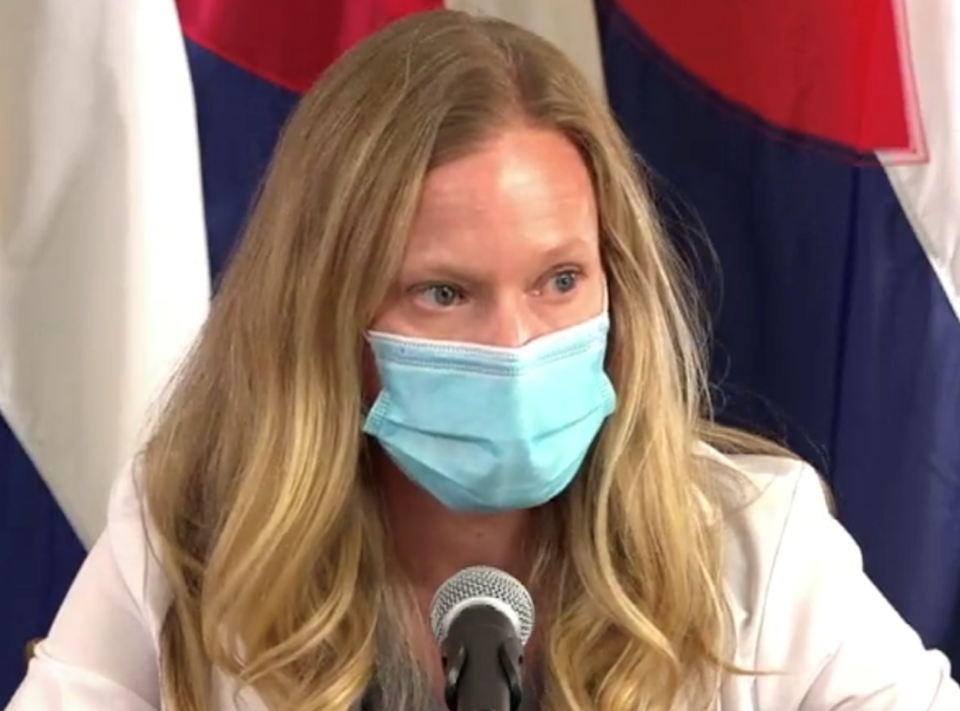Editor's note: This story was originally published by Colorado Newsline. Read the original story here.
***
Two days after the Colorado Department of Public Health and Environment created a new “dial” framework to set thresholds for different levels of COVID-19 restrictions, state officials provided some more clarity about the process.
Whether a county falls under Stay at Home, the most restrictive level and red part of the “dial”; Safer at Home levels 1 (blue), 2 (yellow) or 3 (orange), in the middle range of the dial; or Protect Our Neighbors, the least restrictive level and green part of the dial, depends on three main factors:
• the percent of positive tests
• the amount of cases occurring within a two-week period
• whether hospitalizations for COVID-19 are stable or declining
A new dashboard posted on CDPHE’s COVID-19 website and updated daily shows how each county is doing in terms of those three factors. The color that a county is coded on the first map, under the “Overall Status” tab, represents the level of restrictions each county is currently under. It takes a waiting period of two weeks and multiple conversations between state and local officials for a county to actually move from one level to another on the dial.
“For a county to move to a more restrictive level, what we see is if a county exceeds one of the metrics, they get a two-week grace period, to try to get that metric back under control,” state epidemiologist Rachel Herlihy explained to reporters during a Thursday news briefing.
For example, say a county falls under Safer at Home: Level 1. That level gives counties the ability to allow outdoor events with up to 250 people and indoor events with up to 175 people. One of the three qualifying metrics for that level is having fewer than 75 cases of COVID-19 per 100,000 people over two weeks.
If the county exceeds that metric, it “starts the clock on a two-week period to get back down under that level,” Herlihy said.
“If they don’t get that incidence back down, then what it does is it initiates a consultation process with CDPHE,” she continued. “The goal of this process is to really discuss some of the local circumstances and local factors that are driving the increase in cases.”
As a result of that conversation, the state could extend a county’s grace period to improve their metrics, allowing the county to address their own unique situation — for example, a spike in cases occurring at a university campus but not among the general population. Or, the state could require that a county move to more restrictive levels of social distancing and capacity limits.
In the latter case, the county might move to Safer at Home: Level 2. This level — the midpoint of the dial — includes counties between 75 and 175 new cases of COVID-19 per 100,000 people reported over two weeks.
Under Safer at Home: Level 2, a maximum of 100 people can attend indoor events. Up to 175 people can attend outdoor events.
Counties were assigned levels based on their metrics as of Tuesday. All counties are currently under Safer at Home: Level 1 or Safer at Home: Level 2, except for those that were approved to enter Protect Our Neighbors because of their low transmission levels. Five counties — Moffat, Gunnison, Gilpin, Mesa and Rio Blanco — had been approved for Protect Our Neighbors as of Thursday.
Protect Our Neighbors allows all activities to occur at 50% of normal capacity, with 6-foot social distancing and no more than 500 people in any place at one time. Counties in Safer at Home: Level 1 must go through a certification process before being approved for the Protect Our Neighbors level.
The earliest a county could move to a new level is Sept. 29.
As of Thursday, CDPHE’s dial dashboard showed a handful of counties in danger of moving to a more restrictive level based on their case incidence rate, including Boulder, Logan, Phillips and Yuma counties.
Less-populated counties could have their incidence rates per 100,000 people spike if they experience just a handful of new cases. That will be given consideration in discussions between CDPHE and local public health agencies about whether a county should move to a different level, officials said Thursday.
Meanwhile, Adams County’s hospital admissions could put it in danger of moving to more restrictions. Out of the last 14 days, the county had only six days where hospitalizations were stable or declining (eight days is the target).
Stable or declining hospitalizations are defined as, on any given day, no greater than a 25% increase in the number of people hospitalized for COVID-19, or (for smaller counties) no more than two new COVID-19 hospitalizations on any given day, according to a presentation from state officials.
All other counties had stable or declining hospitalizations as of Thursday.
Colorado Newsline is part of States Newsroom, a network of news bureaus supported by grants and a coalition of donors as a 501c(3) public charity. Colorado Newsline maintains editorial independence. Contact Editor for questions: [email protected]. Follow Colorado Newsline on Facebook and Twitter.



